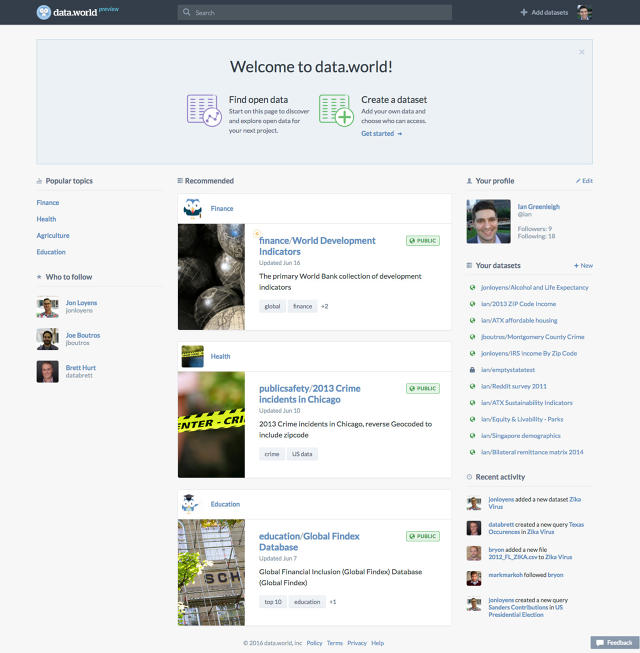Data.World Aims To Be The Social Network For Data Nerds
If the early to mid aughts were about developing all-encompassing social networks for everyone, now it’s about launching whole platforms targeted at a specific industry or subject—think of them like the chat rooms and message boards of web 1.0 but on steroids. Not only will geeks of all varieties be able to commiserate in one place, they’ll be able to collaborate on projects.
There are already early signs of what could be a boiling market for social. Doctors and med students are clamoring to share and study sometimes gruesome images of their patients on Figure 1. On Amino Apps, a collection of targeted apps focused on subjects ranging from Dragon Ball Z to Taylor Swift, people share rumors, fan art, and the best places to download old episodes of their favorite TV shows. The audience size of each app ranges from a few thousand to 100,000, but its engagement can surpass Facebook levels.
The latest entrant is Data.World: a social network geared toward helping data scientists connect and nerd out over collections of data. It’s an ambitious attempt to put lots of data in one place, while also creating a user experience that allows for the unanticipated glee of discovering of new data sets. The company has raised $14 million to develop the platform and is launching today.
“Basically they’re trying to tackle some of the thorniest problems around unlocking some of those pieces in data science that can really show the value of government data in new and interesting ways,” said Jeff Meisel, chief marketing officer at the Census Bureau.
On the inside, Data.World looks a lot like Facebook. Each user gets a profile with a picture and their name and the ability to upload data sets. There is also a “feed” component. Rather than people, Data.World allows users to follow specific data sets.

Users can search for, copy, analyze, and download data sets. Uploading data to Data.World means the data are in one central place and format and can therefore be easily combined, a traditionally difficult task. Data scientists can also connect by commenting on data sets—much like friends communicate on Facebook. Though, at the moment there isn’t any direct messaging capability.
The promise of big data is that by collecting a lot of information people could, with the right analytics, better interpret the way a variety of systems and behaviors work and make predictions about them. It could allow scientists to uncover the minutiae in the ways that cancer changes over time or through a particular course of treatment. Businesses might better comprehend consumers and in turn raise profits.
“If I can really get that apocryphal 360-degree view of the customers, then I can start to run my business more effectively,” says Peter Fader, a professor of marketing at the University of Pennsylvania. “But a lot of people will look at me in the eye and say, ‘easier said than done,’ because the data infrastructure is such a mess.”
While major strides have been made around collecting data, storing, and synthesizing, there are still some hurdles to make big data truly useful. One problem, Fader outlines, is finding data. Let’s say you have information about how often your products are bought and sold in one region, but you don’t have any data about your consumers. You need data from somewhere else. In this instance you can likely get demographic data from the Census Bureau, which shares data publicly. However, those numbers aren’t easy to work with and it’s not always immediately obvious how those multiple data sets fit together.

“Many data scientists say they spend 80% of their time doing data plumbing, just the nitty gritty of aligning key fields—ugly kinds of stuff,” says Michael Chui, partner at McKinsey Global Institute. “Anything we can do to give data scientists more of their brain time to be able to spend on something other than plumbing is going to be great.”
Finding data can also be difficult. While there are many open sets of data from the government’s Open Data initiative, various universities, and certain companies, they’re spread across a plethora of databases. “We don’t have the equivalent of modern day web search for data yet,” says Chui. ‘What we have is more of Yahoo circa mid-’90s.”
In addition to being a social hub for researchers, Data.World could also be the next iteration of data search. On launch, it will have nearly 1,000 data sets available, all pulled from public sources. It’s working directly with the National Science Federation to put the Census Bureau’s open data on the platform. In addition to having a searchable database, the company’s founders are hoping to facilitate further data discovery through the platform’s social component—think of it as digital word of mouth. Furthermore, using artificial intelligence, the platform could also recommend new data sets to researchers—much like Facebook recommends friends.
“In kind of a nirvana state, you would see researchers and collaborators coming together more quickly and trying to tackle problems as they arise,” says Meisel. In a public health crisis, like Zika or the Ebola outbreak for example, it could allow officials to share and analyze data more quickly.
The platform will mostly be free to use, like most social networks. Where people will have to start paying is if they want to upload private data sets—information that won’t be shared with the platform community—that an individual company could run tests on in combination with publicly available data.
related video: Facebook Wants To Win At Everything, Including Artificial Intelligence
Fast Company , Read Full Story
(10)














